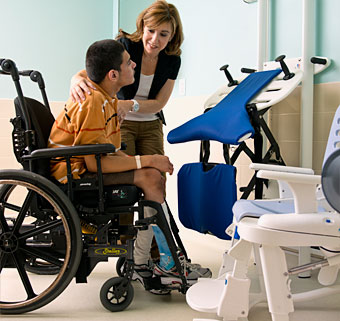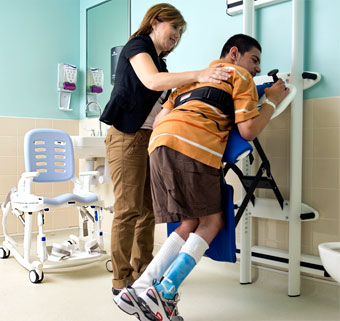The Day School at The Children’s Institute is an approved private school in Western PA. We have 186 students with 27 classrooms. We provide a school program for students with multiple disabilities and for students with autism. All of our students present with severe disabilities affecting motor control, cognition and/or behavior. We have been using MOVE (Mobility Options Via Education) here at our school for several years and had the honor of becoming a MOVE Model Site in November 2015.
 Active Participation in Toileting Can Create Better Outcomes
Active Participation in Toileting Can Create Better Outcomes
Among students with severe physical disabilities, personal hygiene/toileting activities have typically been performed on a horizontal surface such as a changing table or mat table. Performing toileting activities on changing tables or mats invariably involves strenuous lifts and transfers, and undermines the dignity of the students. As a result of introducing MOVE’s Hygiene and Toileting Program, completing personal care activities on horizontal surfaces is no longer the first option we think of here at our school.
MOVE is an activity-based curriculum that encourages students with disabilities to be active participants in every aspect of their daily lives. One critical aspect of daily life is hygiene and toileting, and MOVE’s Hygiene and Toileting program teaches students how to be active participants in their daily toileting routine instead of being passively lifted onto a horizontal surface. The student learns to assist the caregiver in performing a sit-to-stand transfer, maintaining a standing position while clothing is adjusted and moving on and off a toilet or commode.
Incorporating Motor Skill Learning
As noted in the MOVE Hygiene and Toileting program, toileting activities are an opportunity to teach motor skills. Students learn through practice and repetition of the motor skills (transfers, standing, sitting, and pivoting) during every toileting episode throughout the day. As the student practices these skills, they become more self sufficient in the routine. Developing improved ability to transfer and bear weight when toileting is invaluable especially as the student gets heavier and taller and grows into adolescence and adulthood. With more active participation from the student, there is a reduction in the amount of caregiver assistance that is needed. Not only does improved self sufficiency with toileting provide the students with more dignity but also independence and access to natural environments at home, school and the community is enhanced.
Changing the Approach to Toileting
 Having been trained as MOVE International Trainers (MITs) and using the MOVE curriculum here at our school for several years now, we decided we wanted our staff trained in the Hygiene and Toileting program. Our students have been getting more complicated and physically involved over the years and we thought training in the Hygiene and Toileting program would help staff recognize that upright toileting is a possibility for all of our students with multiple disabilities. We also hoped that that providing the Hygiene and Toileting training might facilitate a philosophical change in how our staff thought about, and provided, toileting opportunities for our students. In the spring on 2014 we asked our administrator if we could budget to bring a Hygiene and Toileting trainer to our school. She thought this would be valuable and asked if we could collect data to record how this training impacted our students’ lives.
Having been trained as MOVE International Trainers (MITs) and using the MOVE curriculum here at our school for several years now, we decided we wanted our staff trained in the Hygiene and Toileting program. Our students have been getting more complicated and physically involved over the years and we thought training in the Hygiene and Toileting program would help staff recognize that upright toileting is a possibility for all of our students with multiple disabilities. We also hoped that that providing the Hygiene and Toileting training might facilitate a philosophical change in how our staff thought about, and provided, toileting opportunities for our students. In the spring on 2014 we asked our administrator if we could budget to bring a Hygiene and Toileting trainer to our school. She thought this would be valuable and asked if we could collect data to record how this training impacted our students’ lives.
The Results
Below is the data we collected. It indicates how students were being toileted in June of 2014, before we started, and then a year into the Hygiene and Toileting program. We were hoping we’d see fewer students using changing tables and more students standing for brief changes or, even better, students being given opportunities to sit on toilets even if they were still wearing briefs. And this is exactly what we found. What we did not expect to see is more children now in underwear.
|
|
Spring 2014
|
Spring 2015
|
|
Total Students
|
86
|
100%
|
86
|
100%
|
|
Use Mat Table for Changes
|
23
|
27%
|
13
|
15%
|
|
Stand for Brief Changes
|
24
|
28%
|
23
|
27%
|
|
Uses Toilet, Uses Briefs
|
26
|
30%
|
32
|
37%
|
|
Uses Toilet, Uses Underwear
|
13
|
15%
|
18
|
21%
|
Although this data shows a positive trend, it is far from scientific. For example, it does not indicate who graduated and who was new to our school. However, for our purposes (and our administrator’s) the results were fabulous.
 Overall, MOVE’s Hygiene and Toileting Program gives our classroom teams an opportunity to determine how to include toileting as an educational priority and a process for our students with severe disabilities to be actively involved in their toileting routines. The data demonstrated a change in how we toilet our students given there are more students sitting on toilets now, even if they are still in briefs and less students using high-low tables for brief changes. Perhaps the most exciting news is that some students are having success on the toilet (urinating and bowel movements). Some classroom teams are reporting that these students may be appropriate for participation in a timed toileting program, and, best of all, that even a few students may have the potential to be truly toilet trained!
Overall, MOVE’s Hygiene and Toileting Program gives our classroom teams an opportunity to determine how to include toileting as an educational priority and a process for our students with severe disabilities to be actively involved in their toileting routines. The data demonstrated a change in how we toilet our students given there are more students sitting on toilets now, even if they are still in briefs and less students using high-low tables for brief changes. Perhaps the most exciting news is that some students are having success on the toilet (urinating and bowel movements). Some classroom teams are reporting that these students may be appropriate for participation in a timed toileting program, and, best of all, that even a few students may have the potential to be truly toilet trained!
Back to Top